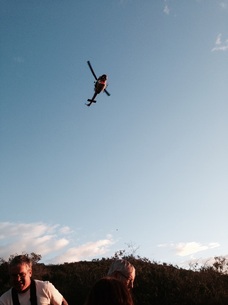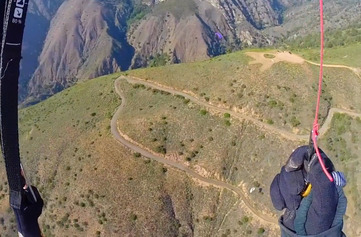- Airspeed, angle of attack, and altitude are your friends.
- When in doubt, go hands up and let the glider fly.
- If you think there is any chance you will run out of altitude prior to recovery from an event involving a severe collapse, stall or spin, throw your reserve. Now.
- Check your reserve for attachment and bag lock.
- Do not become complacent, safe flying requires constant attention and simultaneous awareness of many variables.

He reported encountering some lift, causing the wing to drop back a bit, and simultaneously initiated an intended 180 degree turn from west to east, in order to fly back towards the trail and say hi to another pilot climbing up the trail (me, Dave Metzgar).
He initiated the turn with a strong right brake input, which ultimately caused the right wing to stall and became a spin. After the spin was occurring, he realized what had happened and released the brake, whereupon the glider recovered with a strong surge and swung him into the face of the mountain, resulting in a broken vertebra, broken ribs, etc.
Steve noted that he did not pull the brake any harder than he would have at altitude in order to enter a thermal, and he was surprised when it caused the glider to spin. Moreover, his reaction to the spin was the same as it would have been in a similar situation elsewhere. He believes his accident was the result of complacency – not focusing on flying, his altitude, and his safety margin, but rather on going back to the east to say hi to the pilot climbing the hill, and going in to land.
Bill Davis noted that complacency is a guaranteed killer in situations where lots of things may damage or kill you, like combat situations. Other pilots noted this was not a combat situation, but rather a recreational sporting event where the goal was to have fun. [Note from Dave: that is part of the problem – yes, paragliding is a recreational sport, but it is an extreme sport where all manner of difficult-to-predict situational effects can damage or kill you – I agree with Bill, paragliding requires constant attention and consideration of all possible threats].
Enleau noted that he was surprised the glider spun given the brake input, as seen on the video. Dave noted there may have been some rotor involved, as the wind was switching between SW and NW. Dave noted that the spin initiated rather slowly, and greater awareness of the “barstool rotation” feeling imparted on the pilot during spin initiation could have allowed an earlier response (brake release), and thereby a less vigorous surge away from the hill rather than the strong surge towards the hill that resulted from a delayed release of the brake. Greg noted that, in similar situations, he has recognized that releasing the spin immediately could swing him into a hill, and chose to allow the spin to continue until he was turned away from the hill, so that the surge would carry him away rather than towards the slope.
Dave noted that both earlier recognition of the spin and a more controlled exit could only have been made by a pilot with experience in spins, something that can only safely be gained by practicing deliberate spins at an SIV clinic over the water.
Ultimately, the take-away here is primarily that we need to increase our focus on flying, our situational awareness, and our safety margin (increased airspeed and decreased angle of attack) when we are close to the ground – as is often the case as we are coming in to land in apparently benign evening conditions that would otherwise lull us into complacency. Close to the ground we are more subject to unpredictable changes in wind speed and direction caused by the terrain, and thereby more subject to various stalls and spins. As Enleau would put it, we have very little reserves in our altitude account to allow for recovery if we do stall or spin. So keep your airspeed up and your senses trained on inputs from wind indicators, glider position, and pressure feedback from your glider, and always maintain awareness of your altitude and position relative to the ground.
Bill Helliwell noted that, once a person realizes they are going to hit the ground, it is critical to do so correctly – in the case of a hang glider, by allowing the airframe to take the bulk of the impact. Bill Davis noted that, in paragliders, the important thing in an impending impact is knowing how to do a proper PLF (parachute landing fall) and remembering to do so. If you weren’t trained in proper PLF technique by your instructor, you need to learn and practice the technique yourself until it becomes second nature.

Esperanza was several hundred feet over the terrain, in air that was unlikely to be affected by rotor or other terrain effects. She was thermal flying in moderately turbulent conditions.
Esperanza's glider suffered a significant collapse, to which she responded by pulling relatively hard on one or both brakes. She noted that this was how she had learned to fly her previous glider, on which she was quite light, and that she tended to fly with quite a bit of brake on that previous glider. Her initial brake input caused the glider to spin and/or stall, to which she responded by (at least partially) releasing the brakes.
In the video, it appears as a collapse (apparently wind sheer-induced, likely by a thermal), followed by a spin, which resolves quickly into a stable parachutal stall, followed by a series of nearly-full stalls and partial recoveries. The reserve was thrown just prior to impact, without time to fully open.
In her testimony, Esperanza stated that, when the glider did not spontaneously recover from the parachutal stall, she repetitively pulled both brakes hard in an effort to full-stall the glider, then released the brakes to allow the glider to recover. She stated that this was how she had being taught to recover when a glider did not spontaneously recover from a non-flying configuration. She then threw her reserve when she realized she did not have the altitude to regain normal flight.
Phil noted that the pilot was flying an uncertified extra-small glider of a model that, in other sizes, is certified as a “hot” B-class glider. Such uncertified extra-small gliders often have unpredictable performance and recovery differentials as compared to larger sizes.
Enleau noted that he had flown the same glider, and felt it had very light brake pressure and a relatively short brake travel to the stall point. In any case, the pilot reacted to both the initial collapse and the later parachutal stall with the incorrect action (pulling the brakes rather than fully releasing them), and in both cases did so consciously on the basis of either misinformation or misinterpretation of information.
Phil, Enleau, and others noted that the best reaction to a collapse is, under most situations, to release brake pressure and allow the glider to speed up/increase angle of attack – a momentary brake input can be used prior to a collapse to prevent or limit the collapse as it is happening (on the side of the glider experiencing the collapse), and some counter-steering and weight shift may be necessary to prevent being turned into a hill or another glider - but prolonged brake inputs should be avoided when the glider is trying to recover from a collapse.
Enleau noted that once a stall has been initiated and stabilized, the action required for a recovery is complete release of the brakes – even a small amount of maintained brake pull will prevent the glider from regaining a flying configuration. Furthermore, a full stall should be a last-resort measure, and is only useful in a very specific situation – when the pilot has a lot of altitude to spare, and when the glider has a significant forward cravat (wing tip stuck through the front lines of the glider from the front to the back, which cannot be released until forward motion ceases and allows the tucked wingtip to come forward out of the cravat). The full stall will not fix other types of cravats or tangles, it is a difficult and technical maneuver to perform correctly, and it requires a lot of altitude to perform with any degree of safety.
In a situation such as Esperanza’s (a stall or spin with several hundred feet of altitude), the order of action should have been:
1) Recognize the stall (feel the glider, look at the glider),
2) Assess altitude (ask if there is enough altitude for a safe recovery), then either:
- A) Determine there is enough altitude for a recovery, let the brakes all the way up (even push them up to slack the brake lines), and prepare to check the recovery surge with a momentary and modest brake input if the glider recovers and dives forward (even this “brake check” should only be applied if the glider is diving in front, and be quickly released as the glider comes back overhead). If the glider does not spontaneously recover, leave the brakes slack and either push on the A risers or utilize the speed bar to increase the angle of attack and allow the glider to restart.
- B) Determine there is not enough altitude for a recovery, and immediately throw the reserve parachute.
In this case, the initial accidental stall was exacerbated by the pilot believing that the correct action following the stall event was to deliberately full stall the glider (increase the angle of attack) when the correct action was actually the opposite (use A-riser or speed bar input to decrease the angle of attack and encourage the glider to restart). Furthermore, at low altitudes, a recovery to normal flight and the ensuing surge may result in a high-speed impact, as Steve’s accident demonstrates.
Pilots need to be constantly aware of altitude, and have a clear understanding of the altitude needed for recovery from various sub optimal configurations. If we ever find ourselves in such configurations with less altitude that what is needed to assure a safe recovery, we must choose to throw our reserve without hesitation. And if we find ourselves in such configurations at even lower altitudes, where both recovery and reserve deployment are impossible, we’re left with PLF and prayer – really, the only sensible options are to studiously avoid being low to the ground, or to be hypervigilant and maintain plenty of extra airspeed if we must be low to the ground (for example, on landing approach).
| We also heard from Angela Albota, who described Ziggy’s fatal accident recently at an SIV clinic. Angela reported that Ziggy was flying a small acro wing with acro toggles & through hand grips. He experienced a series of stalls and increasingly intense recovery surges that ultimately led to falling through the lines, then entered a high-speed spiral dive which terminated at the water in a fatal impact. The pilot was told multiple times to throw his reserve, but failed to do so. |
| Bradley Gunnuscio's May 2nd post on Facebook: It is a sad sad day, and one of the hardest things I have ever had to go through... Our deepest sincere condolences goes out to Ziggy's Family and friends. |
Dave pointed out that there are no certifications for packing paragliding and hang gliding reserve parachutes and they are all different. It is therefore the responsibility of the pilot to assure their reserves are correctly packed and operational no matter who packs them.
Everyone should inspect their reserve upon having it repacked, and again prior to any SIV clinics, competitions, or other situations where reserve deployments are common. Inspection should include checking the riser connections and the routing of the risers, checking that the bag is not locked (by carefully pulling the handle until the pins are almost pulled out of their stay loops, to make sure there is enough slack in the strap to allow the pins to be pulled), then fully reinserting the pins, the handle, and the Velcro or tuck flaps. I also check my pins every flight, to ensure that the reserve is not in danger of inadvertent deployment due to the pins coming loose.
Reserve parachutes are generally provided with specific packing instructions, including descriptions of the required orientation of the bag and the deployment strap and handle relative to the reserve container on the harness.
Jason pointed out that bag lock is a very common phenomenon, having been identified in previous safety clinics as being responsible for the in-operability of approximately 20% of tested reserves.



 RSS Feed
RSS Feed

